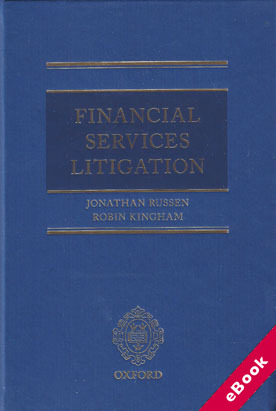
The device(s) you use to access the eBook content must be authorized with an Adobe ID before you download the product otherwise it will fail to register correctly.
For further information see https://www.wildy.com/ebook-formats
Once the order is confirmed an automated e-mail will be sent to you to allow you to download the eBook.
All eBooks are supplied firm sale and cannot be returned. If you believe there is a fault with your eBook then contact us on ebooks@wildy.com and we will help in resolving the issue. This does not affect your statutory rights.
This book primarily provides assistance to litigators who find themselves acting for or against firms in contentious regulatory matters. The material covered is broad in that it covers matters of civil, criminal, administrative, and public law.
It is also highly focused in that it is intended to act as a practical handbook for litigators; detailed explanations are given of practice, procedure, evidence, and remedies at the expense of general commentary on the non-contentious aspects of financial regulation.
The book starts with two chapters that are primarily contextual. Chapter 1 provides an overview of the UK financial regulators whilst paying particular attention to the relationships between them and the ways in which those interactions can pose problems for litigators and the firms they represent. Chapter 2 summarises the authorisation process and its procedures. This chapter also considers the authorisation of EEA firms following Brexit with a focus on procedure and the steps necessary for EEA firms to retain their authorisation following the UK's withdrawal from the EU.
Chapter 3 deals with the increasingly important topic of investigations and information gathering. It pays particular attention to the settlement of investigations and the FCA's procedures for determining discounts.
The heart of this book is found in Chapters 4-7, which cover the various forums in which firms can be challenged for failing to adhere to regulatory standards. Unlike many works dealing with financial services regulation, which so often seem to focus on civil liability, this book aspires to be equally helpful to the criminal litigator. Criminal liability is therefore split in two. Chapter 4 covers practice, procedure, and evidence. Chapter 5 covers the substantive offences, defences, and sentencing.
Civil liability is found in Chapters 6 and 7. Civil enforcement action taken by regulators, including RDC procedure, penalties, and an analysis of the basis and scope of the raft of potential remedies available to the regulator, are covered in Chapter 6. Individual action by investors and consumers is considered in Chapter 7 alongside wider legal principles that may come into play such as litigation. This chapter for the first time includes a detailed analysis of the types of claims often encountered by firms, including case studies on PPI and interest rate hedging products.
Redress, complaints, the Financial Ombudsman Service, and relevant procedure are analysed in Chapter 8. Finally, Chapter 9 provides an overview of the independent methods of challenging regulators, including judicial review and the Financial Services Complaints Commissioner.